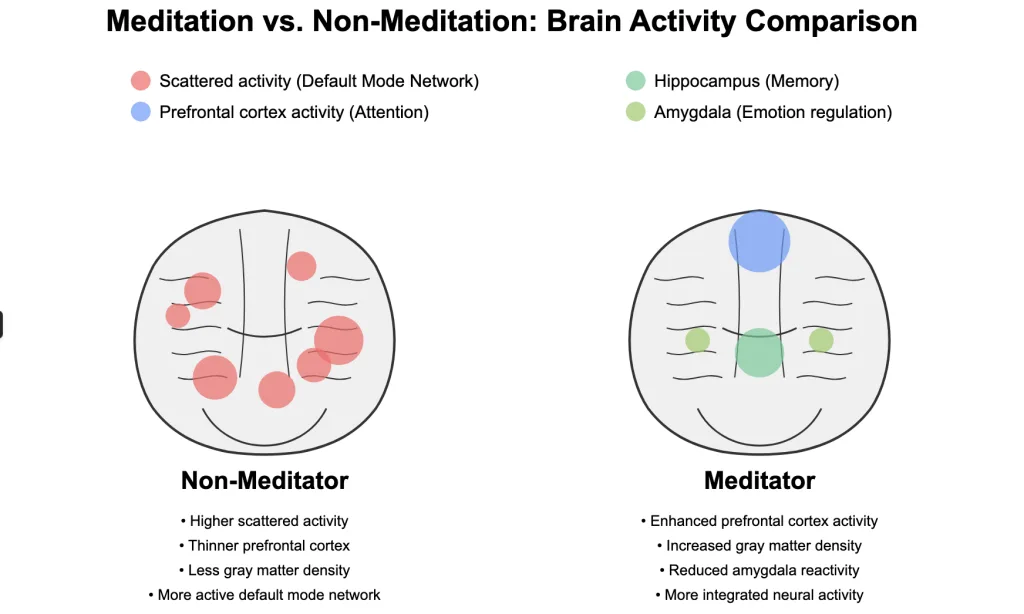In today’s fast-paced world, finding moments of tranquility has become more valuable than ever. Zen meditation, rooted in ancient Buddhist traditions, offers a path to inner peace that countless practitioners have followed for centuries. Whether you’re seeking mental clarity, stress relief, or spiritual growth, Zen meditation—also known as zazen—provides a structured yet profoundly simple approach to mindfulness that can transform your daily life.
I’ve personally found that the beauty of Zen meditation lies in its accessibility. You don’t need to climb a mountain or spend years in a monastery to benefit from this practice. With just a few minutes each day and some basic guidance, anyone can begin experiencing the calming effects of zazen. Let’s explore this transformative practice together, uncovering not only how to get started but how to deepen your journey toward mindfulness and enlightenment.
What Is Zen Meditation and Why Practice It?
Zen meditation (zazen) stands as a cornerstone practice within Zen Buddhism, a tradition that emerged in China before spreading to Japan and eventually worldwide. Unlike some forms of meditation that focus on visualization or mantras, Zen meditation emphasizes “just sitting” with awareness—observing thoughts without attachment while maintaining proper posture and breathing.
The purpose of Zen meditation extends beyond simple relaxation. At its core, zazen aims to help practitioners achieve enlightenment (satori) by directly experiencing reality as it is, free from the distortions of our habitual thinking patterns. Through consistent practice, you begin to see through the illusions that create suffering and discover your true nature.
I’ve noticed in my own practice that zazen creates a unique space where my mind can finally settle down. The constant internal chatter gradually subsides, revealing a profound stillness that feels both unfamiliar and strangely like coming home.
The Science-Backed Benefits of Zen Meditation

Research continues to validate what practitioners have known for centuries—Zen meditation offers remarkable benefits for both mental and physical wellbeing.
Mental Health Benefits
Studies show that regular Zen meditation practice can:
- Reduce symptoms of anxiety and depression
- Improve focus and attention span
- Enhance emotional regulation
- Boost cognitive flexibility
- Promote greater self-awareness
Physical Health Benefits
The benefits extend to physical health as well:
- Lower blood pressure
- Reduced stress hormone levels
- Improved immune function
- Better sleep quality
- Decreased inflammation
Recent research from neuroscience has been particularly revealing. Brain imaging studies show that long-term meditators exhibit increased gray matter density in areas associated with attention and emotional regulation. Additionally, regular meditation practice appears to slow age-related thinning of the cerebral cortex.

Getting Started: Essential Zen Meditation Techniques for Beginners
If you’re new to Zen meditation, the simplicity of the practice might initially seem deceptive. Don’t worry—I felt the same way when I started. Here’s how you can begin your journey:
1. Creating Your Meditation Space
Start by designating a quiet corner in your home where you won’t be disturbed. This doesn’t need to be elaborate—simply a clean, uncluttered area where you can sit comfortably. Some practitioners enjoy having a small Buddha statue or a plant nearby to create a sense of serenity, but this is entirely optional.
2. Proper Posture: The Foundation of Zazen
Posture forms the cornerstone of effective Zen meditation. Unlike casual sitting, zazen requires specific positioning that supports both alertness and stability:
- Sit on a cushion (zafu) with your hips elevated above your knees
- Cross your legs in either full lotus, half lotus, or simply cross-legged if those aren’t comfortable
- Keep your spine straight but not rigid—imagine your head being gently pulled upward
- Rest your hands in your lap, forming the “cosmic mudra” by placing your left hand on top of your right, palms up, with thumbs lightly touching
- Lower your gaze, with eyes half-open, focused about three feet in front of you
- Tuck your chin slightly and relax your shoulders
If sitting on the floor proves too difficult, sitting in a chair is perfectly acceptable as long as you maintain an upright posture without leaning against the backrest.
3. Breathing Technique
Zen meditation emphasizes natural breathing:
- Breathe quietly through your nose
- Allow the breath to settle into its natural rhythm—no need to control it
- When exhaling, let the breath release completely
- When thoughts arise (and they will), simply acknowledge them and return your attention to your breath
4. Starting Slowly
For beginners, I recommend starting with just 5-10 minutes of practice. As your comfort grows, gradually extend your sessions. Even experienced practitioners often maintain shorter daily sessions (20-30 minutes) supplemented by longer weekend practices.
Commonly Asked Questions About Zen Meditation
Let’s address some of the most frequent questions newcomers have about this practice:
What is the purpose of Zen meditation?
The ultimate purpose of Zen meditation is awakening to one’s true nature—what Buddhism calls “enlightenment” or “satori.” However, many practitioners also engage in zazen for its profound benefits for mental clarity, emotional balance, and stress reduction. Unlike goal-oriented activities, Zen meditation emphasizes the practice itself as the goal, encouraging practitioners to release attachment to outcomes.
How does Zen meditation differ from other forms of meditation?
While many meditation traditions emphasize visualization, mantras, or specific objects of focus, Zen meditation takes a uniquely stripped-down approach. The practice centers on “just sitting” (shikantaza) with awareness of the present moment. There are no visualizations to develop, no mantras to repeat—just attending to reality as it unfolds moment by moment, starting with awareness of breath and posture.
This simplicity makes Zen both challenging and profound. Without elaborate techniques to occupy the mind, practitioners directly confront the nature of consciousness itself.
Do I need special equipment for Zen meditation?
While traditional practice utilizes specific equipment, you can start with minimal tools:
| Equipment | Purpose | Essential? | Recommendation for Beginners |
|---|---|---|---|
| Zafu (round cushion) | Elevates hips for proper posture | Helpful but not essential | Start with a firm pillow if needed |
| Zabuton (mat) | Provides cushioning for knees and ankles | Optional | A folded blanket works well |
| Timer | Marks meditation periods | Recommended | Simple smartphone app (silent notification) |
| Loose, comfortable clothing | Allows free movement | Essential | Any non-restrictive attire |
As you deepen your practice, you might consider investing in proper equipment, but don’t let this become a barrier to starting. Many serious practitioners began with nothing more than a quiet space and determination.
How long should I meditate during a Zen session?
Traditional Zen meditation in monasteries often follows strict schedules with sessions lasting 30-40 minutes, separated by walking meditation periods. However, for beginners, this duration can be challenging.
I recommend the following progression:
- Week 1-2: 5-10 minutes daily
- Week 3-4: 15 minutes daily
- Month 2-3: 20-30 minutes daily
- After 3+ months: Consider occasional longer sessions (45-60 minutes)
Remember that consistency matters more than duration. A daily 10-minute practice will likely yield greater benefits than sporadic hour-long sessions.
Can beginners practice Zen meditation?
Absolutely! While Zen’s simplicity might seem paradoxically challenging, beginners often bring a valuable “beginner’s mind”—open, curious, and free from preconceptions. Start with shorter sessions, be patient with yourself, and consider seeking guidance from experienced practitioners or teachers.
Many centers now offer introductory workshops specifically designed for newcomers, providing structured guidance through the fundamentals. Online resources have also made beginner instruction more accessible than ever.
The Journey Beyond Basics: Deepening Your Zen Practice

As your comfort with basic zazen grows, you might explore these dimensions of practice:
Working with Koans
Koans are paradoxical questions or statements used in Zen training to transcend logical thinking. Famous examples include;
- What is the sound of one hand clapping? or
- What was your original face before your parents were born?
Unlike riddles, koans aren’t meant to be “solved” through intellectual analysis. Rather, they serve as focal points that eventually exhaust the logical mind, potentially triggering intuitive insight. Working with koans traditionally occurs under the guidance of an experienced teacher.
Mindfulness in Daily Activities
Zen practice extends beyond formal sitting meditation. Traditional Zen training emphasizes bringing meditative awareness to everyday activities—preparing meals, washing dishes, walking, or working. This continuous practice helps integrate the clarity and presence cultivated during zazen into daily life.
Try selecting one routine activity today—perhaps drinking tea or washing your hands—and perform it with complete attention. Notice sensations, movements, and the tendency of the mind to wander.
Retreats and Intensive Practice
As your practice matures, you might consider participating in a sesshin—an intensive meditation retreat lasting from a weekend to several weeks. These retreats typically involve multiple daily meditation sessions, mindful work periods, and sometimes one-on-one guidance from a teacher.
The structured environment and removal from daily distractions often allows practitioners to experience new depths of concentration and insight. Many find that even a single weekend retreat can significantly deepen their understanding of Zen practice.
The Relationship Between Zen Meditation and Stress Reduction

In recent years, secular mindfulness practices derived from Zen and other Buddhist traditions have gained widespread recognition for stress reduction. While traditional Zen aims at spiritual awakening, many practitioners initially approach the practice seeking relief from anxiety and overwhelm.
How Zazen Affects the Stress Response
Regular Zen meditation practice has been shown to reduce activity in the amygdala—the brain’s threat-detection center—while strengthening connections to prefrontal regions involved in emotional regulation. This neurological shift helps explain why practitioners often report feeling less reactive to stressful situations.
The emphasis on present-moment awareness also interrupts rumination about past events and worrying about the future—two major sources of psychological stress. By continually bringing attention back to the present, meditation practitioners develop the skill of disengaging from stress-inducing thought patterns.
Mindfulness-Based Stress Reduction (MBSR)
While not strictly Zen, the popular MBSR program developed by Jon Kabat-Zinn incorporates many elements of zazen practice. Research on MBSR has shown significant reductions in psychological distress and improved quality of life across diverse populations, from corporate executives to chronic pain patients.
The growing evidence base has helped mindfulness practices gain acceptance in healthcare, education, and corporate settings, making elements of Zen practice accessible to broader audiences.
Common Challenges in Zen Meditation and How to Overcome Them
Even experienced practitioners encounter obstacles in their meditation practice. Here are some common challenges and suggestions for working with them:
Physical Discomfort
Many beginners struggle with physical discomfort during sitting practice. While some discomfort is normal, pain that persists or worsens may indicate a need to adjust your posture.
Solutions:
- Experiment with different cushion heights
- Try alternative postures, including seiza (kneeling) position or chair meditation
- Gradually build up sitting time to condition your body
- Include gentle yoga or stretching before meditation to prepare the body
Mind Wandering
Perhaps the most universal challenge in meditation is the mind’s tendency to wander. You’ll likely find yourself lost in thought repeatedly—this is completely normal.
Solutions:
- Use the breath as an anchor to return to when you notice wandering
- Practice labeling thoughts (“planning,” “remembering,” “judging”) before returning to breath
- Cultivate an attitude of gentle persistence rather than frustration
- Remember that noticing wandering is itself a moment of mindfulness
Drowsiness and Dullness
Feeling sleepy or mentally foggy during meditation is common, especially for beginners or during longer sessions.
Solutions:
- Meditate when alert (often mornings are best)
- Ensure proper posture—slouching encourages drowsiness
- Slightly raise your gaze or open eyes wider
- If persistent, try standing meditation temporarily
Expectations and Impatience
Many beginners become discouraged when they don’t experience immediate calm or insight.
Solutions:
- Remember that meditation benefits accumulate gradually through consistent practice
- Focus on the process rather than expected outcomes
- Keep a simple meditation journal to notice subtle changes over time
- Find community support through a local Zen center or online group
Essential Tools and Resources for Your Zen Practice
Building a sustainable practice often requires supportive tools and resources. Here are recommendations for practitioners at all levels:
Meditation Equipment
| Item | Description | Price Range | Best For |
|---|---|---|---|
| Zafu Cushion | Traditional round meditation cushion filled with buckwheat hulls | $30-70 | Proper posture support during seated meditation |
| Zabuton Mat | Rectangular floor mat providing cushioning for knees and ankles | $40-100 | Comfort during longer meditation sessions |
| Meditation Bench | Wooden kneeling bench for those who find cross-legged sitting difficult | $50-120 | Practitioners with knee or hip limitations |
| Meditation Timer | Simple timer with gentle sounds | $0-30 | Maintaining consistent session length |
| Meditation Clothing | Loose, comfortable attire that doesn’t restrict movement | Varies | Freedom of movement during sitting practice |
Books for Deeper Understanding
For those seeking deeper understanding of Zen philosophy and practice:
- “Zen Mind, Beginner’s Mind” by Shunryu Suzuki
- “The Three Pillars of Zen” by Philip Kapleau
- “The Miracle of Mindfulness” by Thich Nhat Hanh
- “Everyday Zen” by Charlotte Joko Beck
- “Opening the Hand of Thought” by Kosho Uchiyama
Finding Community and Guidance
While solo practice is valuable, connecting with experienced practitioners can significantly enhance your journey:
- Local Zen Centers: Many cities have established Zen centers offering regular practice sessions, workshops, and teacher guidance
- Online Communities: Forums and virtual practice groups provide support for those without local resources
- Retreats: Periodic intensive practice under guidance helps deepen understanding
- Apps and Online Courses: Digital resources offer structured learning for beginners
Integrating Zen Principles into Daily Life
The true test of Zen practice isn’t what happens on the cushion but how it manifests in everyday activities. Here are practical ways to extend meditation benefits throughout your day:
Mindful Transitions
Modern life often involves rushing between activities. Try creating brief mindful pauses between tasks:
- Take three conscious breaths before checking your phone in the morning
- Feel your feet on the ground for a moment before entering a meeting
- Notice sensations in your body while waiting in line
These micro-practices help maintain awareness throughout busy days, preventing the accumulation of stress.
Bringing Zen to Work
The workplace often presents challenges to mindfulness. Consider these approaches:
- Begin meetings with a minute of silence to help everyone become present
- Practice single-tasking rather than constant multitasking
- Schedule brief meditation breaks during the workday
- Apply mindful listening during conversations with colleagues
Mindful Communication
Zen principles can transform how we connect with others:
- Practice speaking only when necessary (avoiding idle chatter)
- Listen fully without planning your response
- Notice reactive emotions before they influence your words
- Cultivate compassion for different perspectives
Simple Living
Zen tradition encourages simplicity and minimalism:
- Regularly declutter your living space
- Consider needs versus wants before making purchases
- Find satisfaction in simple daily activities
- Create technology-free periods in your schedule
The Growing Popularity of Zen Meditation Practices
Interest in Zen and mindfulness practices has grown exponentially in recent years, as evidenced by both scientific research and cultural trends.
Meditation Practice Growth in the US
The percentage of US adults reporting meditation practice has more than tripled in recent years:

This growth reflects broader recognition of meditation’s benefits across diverse populations, including:
- Corporate professionals seeking stress management
- Healthcare patients managing chronic conditions
- Athletes optimizing mental performance
- Students improving focus and learning
- Older adults supporting cognitive health
Scientific Research Trends
Research publications on meditation have shown remarkable growth:
| Time Period | Number of Published Studies on Meditation | Notable Research Focus |
|---|---|---|
| 1970-1980 | < 100 | Physiological responses, stress reduction |
| 1980-1990 | ~300 | Clinical applications, blood pressure |
| 1990-2000 | ~700 | Psychological outcomes, pain management |
| 2000-2010 | ~2,100 | Neuroplasticity, brain imaging |
| 2010-2020 | ~5,000 | Molecular mechanisms, preventive applications |
| 2020-Present | Accelerating | Diverse applications, long-term effects |
This scientific validation has helped bring meditation from the margins to the mainstream, with practices derived from Zen traditions now incorporated into healthcare, education, and corporate wellness programs.
Starting Your Zen Journey Today
The ancient wisdom of Zen meditation offers profound benefits in our modern world. Whether you’re seeking stress reduction, mental clarity, or deeper spiritual insight, the practice of zazen provides a time-tested path forward.
Remember that Zen is fundamentally experiential—no amount of reading or intellectual understanding can substitute for direct practice. The guidance offered here serves merely as a map; the territory must be explored through your own sitting practice.
I encourage you to begin simply: find a quiet space, sit comfortably with an upright posture, and bring gentle attention to your breath for just five minutes. From this humble beginning, a transformative practice can grow.
As an ancient Zen saying reminds us: “Before enlightenment, chop wood, carry water. After enlightenment, chop wood, carry water.” The profound truth of Zen isn’t found in esoteric experiences but in bringing full presence to ordinary life. Your journey begins with the very next breath.
Attention! Freebie!





